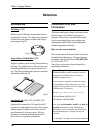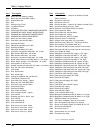
v
Appendix A: Cooking Guides
Broiling Guide
All times are approximate since variables such as thickness, temperature and individual prefer-
ences will affect the cooking time. Broiling is done with the door shut and the broil temperature
may be adjusted in 5-degree increments. High is 550°F/290°C and generally used for quick
searing and for rare meats. Medium - High is good for cooking meat well done. Lower tem-
peratures are useful for melting cheese, browning meringues, etc.
The closer the meat is placed to the broil element, the faster the surface browns which is very
good for rare meats. The further away the meat is placed the slower the surface will brown and
this is best for more well done meat or thicker cuts.
Broil meat on lightly greased broiler pan or on roaster/broiler rack locked in the broiler pan
provided. Convection broil is very useful for thick pieces of meat and should be done on the
roaster/broiler rack so hot air can circulate around the meat. Turn meat with tongs, not a fork so
as not to pierce meat and loose juices. To test for doneness make a small slash in center of meat
not at the edge where more juices will be lost.
RACK POSITION: The positions of racks may be adjusted for desired results. For standard
broiling on broiler pan use rack position 2 or 3 or on roaster/broiler rack on rack position 2.
Meat Cut Degree of
“Doneness”
Thickness
In. Cm.
Approximate
Cooking Time
In minutes
Rare 5-6/sideSteaks
Medium 7-8/side
Beef
Ground beef patties Well done or
internal temperature
of
160F/70C
¾-1 2
6-8/side
Pork
Pork chops or kabobs Until no longer pink ¾-1 2 5-6/side
Lamb
Lamb cops or kabobs Medium-rare 1 2 5-7/side
Chicken parts Until juices run clear 25-40
Chicken
Boneless breasts Until no longer pink 6-8/side
Whole or steaks 10/inch (2.5 cm)
Boneless fillets
Until it flakes with a
fork
5-10 total
Fish
Lobster tails, thawed 8-10 total


















